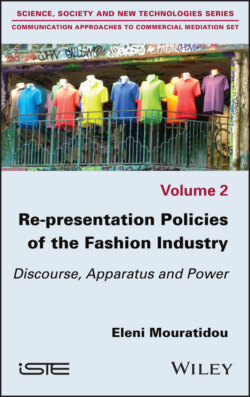Читать книгу Re-presentation Policies of the Fashion Industry - Eleni Mouratidou - Страница 20
I.9. Staging of the work
ОглавлениеIn addition to its introduction and conclusion, this book is structured by three parts and six chapters, each part comprising two chapters. I have opted for a relatively atypical structure in the way in which the various stakes of this research are presented. In the first two parts, I present re-presentation policies of the actors and groups of the fashion industry before addressing the socioeconomic stakes of the sector and the models that structure it. This choice may indeed appear to be atypical because it does not allow us to get to the heart of the matter, which is the link between the economic models of the luxury fashion industry and the way in which this industry sets itself up in order to disguise some of the constituent elements of its models and in general of its industrialization. I chose this organization based on the following observation: as ordinary spectators of fashion brands, their communication strategies and their merchandise, we are first and foremost confronted with the sector’s re-presentational policies, long before we are interested in the industrial workings that organize it34. The fashion industry’s re-presentation policies are part of the visible, exposed and circulating face of the sector, which millions of spectators are confronted with on a daily basis35. It is this visible face, its rewritings and its circulations that I wanted to first expose in order to report and discuss the way in which the fields of art, culture, religion, the sacred and politics are invited into the visible activities of the fashion industry. Part 1 will address the processes of culturization and artification that characterize the sector’s re-presentation policies. I will look upstream at the so-called “traditional” communication and marketing strategies, such as media advertising, ready-to-wear collections and distribution strategies (Chapter 1), while downstream I will study the way the fashion industry occupies spaces that belong to art and culture while transforming its boutiques into places with artistic aims (Chapter 2). Part 2 will address belief and engagement as they result from intertextual, anaphoric and sometimes parodic processes in the religious, sacred (Chapter 3) and political (Chapter 4) realms. Part 3, on the one hand, will deal with the industrialization processes of luxury fashion, its managerial creativity and the resulting dysphoric stakes (Chapter 5); on the other hand, it will expose the mechanisms that contribute to the establishment of the symbolic and economic power of the fashion industry’s representational device through a new processing of certain elements of the corpus analyzed throughout parts 1 and 2 of this book (Chapter 6).
